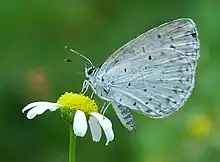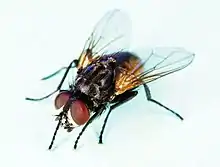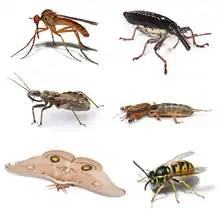Panorpida
Panorpida or Mecopterida is a proposed superorder of Endopterygota. The conjectured monophyly of the Panorpida is historically based on morphological evidence, namely the reduction or loss of the ovipositor and several internal characteristics, including a muscle connecting a pleuron and the first axillary sclerite at the base of the wing, various features of the larval maxilla and labium, and basal fusion of CuP and A1 veins in the hind wings.[1][2] The monophyly of the Panorpida is supported by recent molecular data.[3]
| Panorpida |
| ||||||||||||||||||||||||||||||||||||
| Panzygothoraca |
| ||||||||||||||||||
| part of Endopterygota |
| Panorpida | |
|---|---|
 | |
| Celastrina argiolus | |
| Scientific classification | |
| Domain: | Eukaryota |
| Kingdom: | Animalia |
| Phylum: | Arthropoda |
| Class: | Insecta |
| (unranked): | Endopterygota |
| Superorder: | Panorpida |
| Clades | |
Antliophora
The Panorpid clade Antliophora contains one of the major phylogenetic puzzles among the Insecta. It is unclear as of 2020 whether the Mecoptera (scorpionflies and allies) form a single clade, or whether the Siphonaptera (fleas) are inside that clade, so that the traditional "Mecoptera" is paraphyletic. However the earlier suggestion that the Siphonaptera are sister to the Boreidae (snow scorpionflies)[4][5][6] is not supported; instead, there is the possibility that they are sister to another Mecopteran family, the Nannochoristidae of the Southern hemisphere. The two possible trees are shown below:[7]
(a) Mecoptera is paraphyletic, containing Siphonaptera:[7]
| Antliophora |
| ||||||||||||||||||||||||
(b) Mecoptera is monophyletic, sister to Siphonaptera[7]
| Antliophora |
| ||||||||||||||||||||||||
References
- Kristensen, Niels Peder (1975). "The phylogeny of hexapod "orders". A critical review of recent accounts". Journal of Zoological Systematics and Evolutionary Research. 1 (13): 1–44. doi:10.1111/j.1439-0469.1975.tb00226.x.
- Kristensen, Niels Peder (1991). "Phylogeny of extant hexapods". Insects of Australia: 126–140.
- Grimaldi, David; Engel, Michael, S. (2005). Evolution of the Insects. Cambridge University Press. p. 468. ISBN 978-0-521-82149-0.
{{cite book}}: CS1 maint: multiple names: authors list (link) - Whiting, Michael F.; Whiting, Alison S.; Hastriter, Michael W.; Dittmar, Katharina (2008). "A molecular phylogeny of fleas (Insecta: Siphonaptera): origins and host associations". Cladistics. 24 (5): 677–707. CiteSeerX 10.1.1.731.5211. doi:10.1111/j.1096-0031.2008.00211.x. S2CID 33808144.
- Whiting, Michael F. (2002). "Mecoptera is paraphyletic: multiple genes and phylogeny of Mecoptera and Siphonaptera". Zoologica Scripta. 31 (1): 93–104. doi:10.1046/j.0300-3256.2001.00095.x. S2CID 56100681. Archived from the original on 2013-01-05.
- Wiegmann, Brian; Yeates, David K. (2012). The Evolutionary Biology of Flies. Columbia University Press. p. 5. ISBN 978-0-231-50170-5.
Recently, a close affinity between Siphonaptera and Mecoptera has been convincingly demonstrated via morphology (Bilinski et al. 1998) and molecular data (Whiting 2002), rendering Mecoptera paraphyletic, but making the clade including Mecoptera and Siphonaptera monophyletic
- Meusemann, Karen; Trautwein, Michelle; Friedrich, Frank; Beutel, Rolf G.; Wiegmann, Brian M.; et al. (2020). "Are Fleas Highly Modified Mecoptera? Phylogenomic Resolution of Antliophora (Insecta: Holometabola)". bioRxiv 10.1101/2020.11.19.390666.
- Minet, J.; Huang, D-y.; Wu, H.; Nel, A. 2010: Early Mecopterida and the systematic position of the Microptysmatidae (Insecta: Endopterygota). Annales de la Société Entomologique de France (n.s.), 46: 262-270. ISSN 0037-9271




.jpg.webp)
